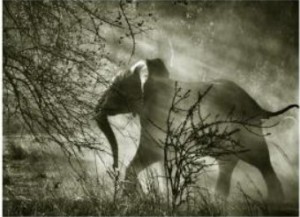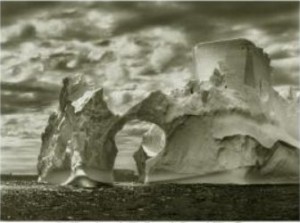Genesis, by Sebastião Salgado: Exhibition Review
BRICS, LATIN AMERICA AND THE CARIBBEAN, REVIEWS, ARTS, 27 May 2013
Sumeet Grover – TRANSCEND Media Service
Our tiny planet earth incessantly spins; sometimes as we are stood, we are hanging outwards to the southern universe and pulled upwards by earth’s stern fatherly gravity, whilst at other times we are perhaps pointing westwards, eastwards or we never know in which direction of the galaxy. Yet, we continue to believe that we walk on and inhabit a flat earth, that we humans are the ruling creatures, that we could divide this ancient soul’s lifespan by BCs unpredictable and ADs to come, that nation-state boundaries always existed like criss-crossed lines on an elderly grandmother’s face, that over two hundred countries and territories is all that sums its land and waters, that we need to venture out into the space to ascertain we are not alone; we feel locked on this planet with more waters than land for ever-multiplying humans and their needs. Do we know enough?
Genesis, an unfathomable eight-year long work, that took the Brazilian documentary photographer Sebastião Salgado to 32 countries, explores the earth in the way it must have originated and the way its vast undiscovered stretches have remained untouched. It asks us, the humans, to question our view of this world and our relationship with this fragile planet that is powerful enough to create, sustain as well as destroy; but it is equally powerless when stood in front of the extents to which the ignorant and self-destructive human instincts have accelerated. 200 of Salgado’s photographs from Genesis are on display at the National History Museum, London, until 8th September 2013.
There are about five sections across which these photographs have been spanned out: Planet South, Sanctuaries, Africa, Amazonia and Pantanal, and Northern Spaces. As curator Lélia Wanick Salgado remarks, each of these photographs capture our world ‘in all its unspoiled grandeur’. Therefore, to contemplate upon every photograph at the exhibition is a task that is better left to the audience, so that they can make sense of the associated meaning very personally. But what stands out across all these photographs is the prodigiously overwhelming beauty, landscapes and the stories Sebastião Salgado has captured from a comparably diminutive camera lens, and locked a naked majestic world in his camera shutters. There is a very inviting and entangling intimacy in all of his photographs that one can spend several hours looking at.
From a large number of extraordinary and gripping photographs in Genesis, a few of them are as follows. Volcano photographs include pictures of the lava cactus plant found on the barren lava flows at Galapagos Islands in Ecuador, vegetation on the slopes of over 4,000 metre high Muhabura volcano in Uganda, and an inside-crater view of Nyiragongo volcano at the moment of explosion at the Democratic Republic of Congo.
Tribal life around Oceania and Africa include the Yali, Korowai and San, most of whom live naked except covering their genitals; their photographs invite thought and discussion as to why thousands of women and men are raped in the world’s non-tribal, developed lands. It is thrilling to see that the Korowais in West Papua, Indonesia, build wooden houses and erect them on trees that are about six to twenty-five metres tall; up to eight family members live in each house, all without many clothes or sophisticated possessions. A striking picture of a Yali father and daughter, at the same region in Indonesia, demonstrates the most important clothing for these tribes are skirts for women and kotekas or penis guards for men. Equally energetic is the picture of the San tribe men in Botswana, performing their healing or trance dance that marks their entry into the world of spirits.
A fearless and scare-some leopard, stood in the Barab River Valley, stares calculatedly at the photographer in Namibia, whilst the rarest of the three species of gorillas, the mountain gorilla enjoys a full-face photograph that vividly captures its tiniest of expressions and facial details at Mount Bisoke in Rwanda. There are relentless close-up pictures of these animals unknown, whose facial expressions not only tell us that they don’t need us bigoted humans who have built nuclear weapons to destroy them, they also send us a message that they have existed for millennia on their own and will continue to do so, irrespective of whoever thinks they own the territories these creatures live upon; they are the undeniable rulers of their lands, waters, icebergs and mountains.
There is a dramatic picture of the southern right whale emitting distinctive V-shaped vapours from in front of its mouth through its two separate blow holes; the vapours rise high in the air as this creature that weights between 30 and 50 tonnes makes its way ahead in the far-stretching waters around Valdes Peninsula, Argentina. On the other hand, there are pictures in a row of the chinstrap penguins from the South Sandwich Islands; how could we have ever imagined that there are around 750,000 couples of these penguins, thousands of them photographed, on snow-captured mountains at the Zavodovski Island. These penguins, who solitarily rest upon icebergs sculpted by our frail and melting earth, inhabit a planet we are yet to comprehend, and must do so before its increasingly melting ice turns into water graveyards.
This exhibition is to be visited for every single of its 200 photographs on display. The world première of Sebastião Salgado’s exhibition at the National History Museum, London, brings us an unseen ancient earth, unspoiled and magnanimous, revealing untold stories and unseen wisdom that exists on our planet to preserve our future. Salgado deserves to win not just an environmental award, but also a peace prize for his work that is pulsating with his passion to protect nature and life, and to advocate sustainability in the direct words of our planet’s timeless wisdom. We should be grateful to the Brazilian mining company, Vale, for their generous support to materialise this exhibition when our own grey bar-charted economy is trimming the arts funding, like elsewhere in the world, humans are trimming forests and water resources.
__________________________
Sumeet Grover:
– Member of the TRANSCEND Network for Peace, Development and Environment and of the TRANSCEND Art & Peace Network
– Coordinator of Global Poetry
– A software engineer originally from India, based in the UK.
This article originally appeared on Transcend Media Service (TMS) on 27 May 2013.
Anticopyright: Editorials and articles originated on TMS may be freely reprinted, disseminated, translated and used as background material, provided an acknowledgement and link to the source, TMS: Genesis, by Sebastião Salgado: Exhibition Review, is included. Thank you.
If you enjoyed this article, please donate to TMS to join the growing list of TMS Supporters.

This work is licensed under a CC BY-NC 4.0 License.
One Response to “Genesis, by Sebastião Salgado: Exhibition Review”
Read more
Click here to go to the current weekly digest or pick another article:
BRICS:
- The “BRICS Sovereigns” vs the “Globalist Oligarchy”
- Cuba Joining BRICS Is a Lifeboat for Its Economy
- BRICS and G20 Value Platforms: A Comparative Analysis
LATIN AMERICA AND THE CARIBBEAN:
- ‘Haiti’s Survival Is at Stake,’ Says UN Expert, Warning of Worsening Crisis
- Women's Interdepartmental Coalition of Haiti
- Biden or Trump, US Latin American Policy Remains Contemptible: Migration, Drugs, Tariffs
REVIEWS:
- MIT Science for Genocide
- We the People: Whistleblowers, Whistleblowing & Retaliation in the United Nations
- It’s Not You, It’s CAPITALISM
ARTS:


[…] Huffington Post UK | TRANSCEND Media Service […]